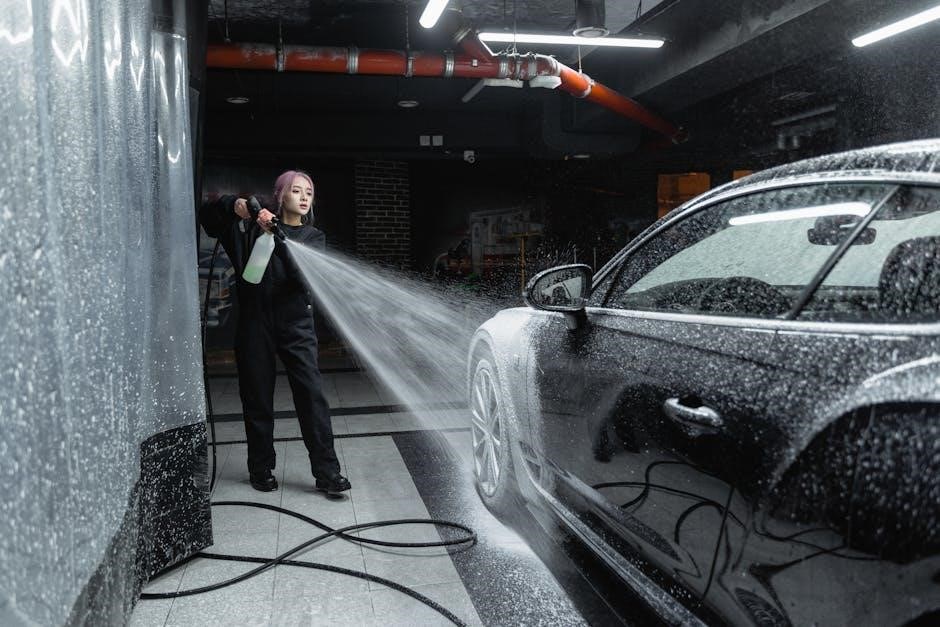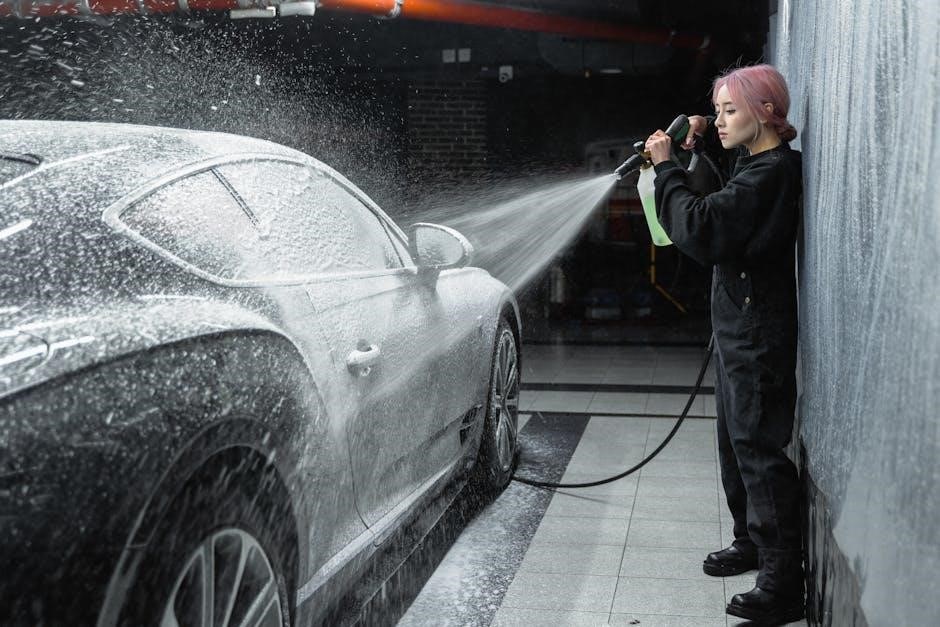A pressure washer manual is an essential guide for understanding your equipment’s operation, safety, and maintenance․ It provides detailed instructions to ensure safe and effective use, helping you maximize performance while minimizing risks․ Reading the manual is crucial for troubleshooting and maintaining your pressure washer efficiently․
1․1 Importance of Reading the Manual
Reading the pressure washer manual is crucial for safe and effective operation․ It provides essential safety guidelines, operational instructions, and troubleshooting tips․ The manual helps users understand proper usage, avoiding potential damage to surfaces or the equipment itself․ It also ensures compliance with manufacturer recommendations, reducing risks of accidents․ By following the manual, users can optimize performance, extend the lifespan of the pressure washer, and address common issues efficiently․ Neglecting to read the manual may lead to improper use, safety hazards, or equipment malfunctions․ It is a vital resource for both novice and experienced users, ensuring a smooth and successful cleaning experience․
1․2 What to Expect in a Typical Manual
A typical pressure washer manual includes detailed information to guide users through safe and effective operation․ It usually starts with safety guidelines, followed by assembly and setup instructions․ The manual also covers operational procedures, including how to start, adjust pressure settings, and use various nozzles or attachments․ Maintenance tips, troubleshooting common issues, and storage recommendations are also standard․ Additionally, it may provide FAQs, warranty details, and environmental considerations․ The manual serves as a comprehensive guide, ensuring users understand their equipment fully․ By following the manual, users can optimize performance, prevent damage, and extend the lifespan of their pressure washer․ It is a vital resource for both novice and experienced users․

Safety Guidelines in Pressure Washer Manuals
Safety guidelines in pressure washer manuals emphasize proper handling, protective gear, and precautions to avoid injury․ They outline risks and best practices for safe operation․
2․1 General Safety Precautions
General safety precautions are crucial when operating a pressure washer to prevent accidents and ensure safe usage․ Always wear protective gear, including gloves, safety goggles, and closed-toe shoes, to shield yourself from high-pressure streams and debris․ Maintain a safe distance from the nozzle to avoid injury․ Never aim the pressure washer at people, pets, or sensitive surfaces like windows or electrical components․ Use the correct nozzle for the task to avoid excessive force․ Keep children and bystanders away while operating the machine․ Ensure the area is clear of obstacles and avoid using the pressure washer in slippery or uneven conditions․ Follow all guidelines to prevent damage to surfaces and equipment․
2․2 Handling Precautions
Proper handling of a pressure washer is essential to ensure safe and effective operation․ Always use both hands to hold the spray gun, maintaining a firm grip to control the nozzle․ Avoid using the pressure washer in slippery or uneven surfaces, as this can lead to loss of control․ Keep the hose organized and free from kinks or tangles to prevent accidental tripping or damage․ Never leave the pressure washer unattended while it is running, as it can cause unintended damage or injury․ Be cautious of the high-pressure stream and avoid spraying it near sensitive areas or living organisms․ Proper handling ensures both your safety and the longevity of the equipment․
2․3 Protective Gear Recommendations
Pressure washer manuals emphasize the importance of wearing protective gear to ensure user safety․ Essential items include safety goggles or glasses to protect eyes from debris, gloves to prevent cuts and abrasions, and closed-toe shoes to safeguard feet․ Long sleeves and pants can shield skin from high-pressure streams․ Some manuals recommend additional gear like face shields or hearing protection, especially for industrial models․ Proper attire helps prevent injuries and enhances comfort during use․ Always ensure gear fits well and is in good condition for optimal protection․ These recommendations are crucial for safely operating pressure washers, especially at higher pressures or with chemical additives․

Understanding Pressure Washer Components
A pressure washer consists of key components like pumps, motors, hoses, and nozzles․ Understanding these parts is essential for proper operation, maintenance, and troubleshooting, ensuring optimal performance and longevity․
3․1 Overview of Key Components
A pressure washer consists of several essential components that work together to deliver high-pressure water flow․ The engine or motor powers the system, while the pump pressurizes the water․ The hose transports water from the pump to the spray gun, which includes a trigger for controlling water flow․ The nozzle at the end of the gun adjusts the spray pattern․ Additional components like filters and pressure regulators ensure optimal performance․ Understanding these parts is crucial for proper assembly, operation, and maintenance, as outlined in the manual․
3․2 Identifying Parts and Their Functions
Understanding the components of your pressure washer is vital for effective operation․ Key parts include the pump, engine, hose, spray gun, and nozzles․ The pump generates high-pressure water flow, while the engine powers it․ The hose connects the pump to the spray gun, which houses interchangeable nozzles for varying spray patterns․ Additional components like pressure regulators and detergent tanks enhance functionality․ Familiarizing yourself with these parts ensures proper use and maintenance, as outlined in the manual․ Identifying each part’s role helps in troubleshooting and maintaining your pressure washer efficiently, ensuring optimal performance and longevity of the equipment․

Assembly and Initial Setup
Begin by carefully unpacking and inventorying all components․ Follow the manual’s step-by-step assembly guide to ensure proper setup․ After assembling, perform the initial start-up procedure to test functionality․ If unsure, consult the manual for clarification to avoid issues․
4․1 Unpacking and Inventory
When you receive your pressure washer, carefully unpack all components and verify the contents against the provided inventory list․ Ensure the unit, hose, spray gun, nozzles, and manual are included․ Inspect each part for damage or defects․ If any items are missing or damaged, contact the manufacturer immediately․ Organize the accessories to prevent loss and store them in a dry, secure location․ Before proceeding with assembly, familiarize yourself with the parts and their purposes․ This step ensures a smooth setup process and helps identify any potential issues early․ Always refer to the manual for specific unpacking instructions tailored to your model․
4․2 Step-by-Step Assembly Instructions
Begin by carefully unpacking all components and verifying the inventory against the manual’s list․ Start with the base unit, then attach the handle securely using the provided bolts․ Next, connect the high-pressure hose to both the pump and the spray gun, ensuring tight fittings․ Install the nozzle or spray tip according to the manual’s guidance․ If your model includes additional attachments, such as a detergent tank or brush, follow the specific instructions for their installation․ Double-check all connections for leaks or loose parts․ Finally, refer to the manual for proper alignment and tightening of any remaining components before proceeding to the initial start-up․
4․3 Initial Start-Up Procedures
Before starting your pressure washer, ensure all components are properly assembled and secured․ Check for any damage or missing parts․ Locate a suitable outdoor area away from flammable materials․ Add the recommended fuel or connect to a power source as specified․ Turn on the water supply and ensure the hose is securely attached․ Follow the manufacturer’s instructions to prime the pump if necessary․ Start the engine or motor according to the guide․ Allow it to run for a few minutes to ensure proper function․ Test the pressure settings and nozzle spray patterns․ Refer to the safety guidelines before proceeding․ This ensures a safe and effective initial startup․

Operating Instructions
Start with basic settings, gradually adjusting pressure and nozzle types for specific surfaces․ Always follow guidelines to avoid damage and ensure optimal cleaning effectiveness․
5․1 Basic Operation Guidelines
Before starting your pressure washer, ensure all connections are secure and the water supply is turned on․ Always wear protective gear, including gloves and safety goggles․ Begin by priming the pump if required, then pull the starter cord or press the power button․ Adjust the pressure setting based on the surface you’re cleaning, using lower settings for delicate areas․ Hold the spray gun firmly, keeping the nozzle at least 12 inches away from surfaces to avoid damage․ Use a sweeping motion to clean evenly, avoiding direct spray on sensitive materials like windows or electrical components․ Refer to your manual for specific guidelines tailored to your model․
5․2 Adjusting Pressure Settings
Adjusting pressure settings on your pressure washer is crucial for effective cleaning and preventing surface damage․ Most models come with a pressure regulator or adjustable nozzle․ Always refer to your manual for specific instructions, as settings vary by model․ Start by turning the regulator dial clockwise to increase pressure or counterclockwise to decrease it․ Test the setting on a low-pressure surface first to ensure it’s appropriate for your task․ For delicate surfaces, use a wide-angle nozzle with lower pressure․ For tough stains, switch to a narrower nozzle for higher pressure․ Adjustments may also depend on detergent use or specific attachments․ Proper pressure setting ensures optimal cleaning results and extends equipment lifespan․
5․3 Using Different Nozzles and Attachments
Pressure washers often come with interchangeable nozzles and attachments, each designed for specific tasks․ The most common nozzles include 0°, 15°, 25°, and 40° sprays, with narrower angles for heavy-duty cleaning and wider angles for delicate surfaces․ Attachments like brushes or detergent injectors enhance versatility․ Always match the nozzle to the job to avoid surface damage․ For example, use a 40° nozzle for washing cars or windows, while a 0° nozzle is better for concrete or tough stains․ Refer to your manual for proper attachment installation and usage guidelines․ Using the right nozzle and attachment ensures efficient cleaning and protects both the surface and your equipment․

Troubleshooting Common Issues
Pressure washers come with various nozzles and attachments for specific tasks․ The 0° nozzle is ideal for heavy-duty cleaning, while the 40° nozzle is better for delicate surfaces․ Attachments like brushes or detergent injectors enhance versatility․ Always match the nozzle to the job to avoid surface damage․ For example, use a 40° nozzle for washing cars or windows, while a 0° nozzle is better for concrete or tough stains․ Refer to your manual for proper installation and usage guidelines․ Using the right nozzle and attachment ensures efficient cleaning and protects both the surface and your equipment․
6․1 Identifying Common Problems
Common issues with pressure washers include low water pressure, engine malfunction, or pump failure․ These problems often arise from improper maintenance, clogged nozzles, or incorrect pressure settings․ Users may also encounter difficulties with starter mechanisms or overheating engines․ Additionally, issues like leaking hoses or faulty valves can disrupt operation․ Identifying these problems early is crucial to prevent further damage and ensure optimal performance․ Always refer to the manual for specific troubleshooting steps tailored to your model․ Regular maintenance and adherence to safety guidelines can help mitigate many of these common issues․ Addressing problems promptly ensures longevity and efficiency of your pressure washer․
6․2 Diagnostic Techniques
Diagnosing issues with your pressure washer involves a systematic approach․ Start by identifying symptoms, such as low water pressure, engine sputtering, or pump failure․ Perform a visual inspection to check for blockages, worn-out seals, or loose connections․ Test the water supply to ensure it’s adequate, and verify that all hoses and nozzles are clear․ Consult the manual for specific diagnostic procedures, as some models may have unique features․ If the problem persists, isolate components like the pump or engine to determine the root cause․ Accurate diagnosis is key to effective troubleshooting and ensures your pressure washer operates efficiently․
6․3 Solutions for Engine and Pump Issues
For engine issues, check oil levels and replace spark plugs if necessary․ If the pump malfunctions, inspect for blockages or worn seals․ Replace faulty components promptly․ Ensure proper fuel and detergent usage to avoid damage․ Regular maintenance, like cleaning filters, can prevent engine and pump problems․ If issues persist, consult a professional or refer to troubleshooting guides in the manual for detailed repair steps․ Proper storage and seasonal preparation are also key to maintaining engine and pump health․ Always follow manufacturer guidelines for repairs to ensure safety and optimal performance․ Addressing these issues early prevents costly damages and extends the equipment’s lifespan․

Maintenance and Care
Regular maintenance ensures your pressure washer performs optimally․ Clean the machine, check for wear, and store it properly to extend its lifespan and efficiency․
7․1 Routine Maintenance Schedule
A routine maintenance schedule is crucial for extending the life of your pressure washer․ Regularly check the oil level and top it off as needed; Inspect hoses for cracks or damage and replace them if necessary․ Clean or replace the filter to ensure proper water flow․ Lubricate moving parts, such as the pump and motor, to prevent friction damage․ Check the belts for wear and tighten or replace them as required․ Schedule maintenance every 50 hours of use or as specified in the manual․ Proper upkeep ensures optimal performance and prevents costly repairs․
7․2 Cleaning the Pressure Washer
Cleaning your pressure washer is essential for maintaining its performance and longevity․ Regularly inspect and rinse the nozzle to prevent clogs․ Use a soft brush to remove debris from the exterior and hoses․ For tougher dirt, mix mild detergent with water, apply it to the unit, and rinse thoroughly․ Avoid using harsh chemicals or abrasive cleaners, as they may damage components․ After cleaning, dry the pressure washer to prevent rust․ Pay special attention to the pump and engine, ensuring no moisture remains․ Cleaning regularly helps prevent mineral buildup and ensures optimal functionality․ Always refer to your manual for specific cleaning recommendations tailored to your model․
7․3 Storing the Pressure Washer
Proper storage of your pressure washer is crucial to maintain its performance and longevity․ Always drain fuel from the tank and hoses before storing to prevent residue buildup․ Clean the unit thoroughly, paying attention to the pump and nozzle areas, to avoid clogging․ Store the pressure washer in a dry, well-ventilated area away from direct sunlight and freezing temperatures․ Use a protective cover to shield it from dust and moisture․ Ensure the washer is placed on a stable, elevated surface to prevent damage from pests or water accumulation․ Regularly inspect stored components for signs of wear or corrosion․ Follow these steps to ensure your pressure washer remains in optimal condition when not in use․

Advanced Features and Settings
Explore advanced features like variable pressure controls, detergent injection systems, and specialized nozzles for customized cleaning․ These settings enhance efficiency and adaptability for diverse cleaning tasks․
8․1 Understanding Pressure Settings
Pressure settings are crucial for effective cleaning and preventing damage․ Most pressure washers offer adjustable settings, typically measured in pounds per square inch (PSI)․ Lower settings (1,200–2,000 PSI) are ideal for delicate surfaces like windows or cars, while higher settings (2,400–4,000 PSI) are better for heavy-duty tasks like concrete or decks․ Overusing high pressure can strip paint or damage materials, so it’s important to match the setting to the task․ Always start with the lowest recommended pressure and adjust as needed․ Proper pressure control ensures efficiency and safety, preventing unnecessary wear on both the surface and the equipment․ Consult your manual for specific guidance on pressure settings for various applications․
8․2 Using Detergents and Chemicals
Using the right detergents and chemicals with your pressure washer enhances cleaning efficiency but requires careful consideration․ Always use solutions specifically designed for pressure washers to avoid damaging surfaces or the equipment․ Start with a mild detergent for general cleaning and switch to stronger formulas for tougher stains or grease․ Avoid using bleach or abrasive chemicals, as they can harm surfaces or degrade seals․ Dilute detergents according to the manual’s instructions to ensure optimal performance․ For eco-friendly practices, opt for biodegradable cleaners․ Properly rinse surfaces after applying chemicals to prevent residue buildup․ Dispose of leftover chemicals responsibly, following environmental guidelines to minimize impact․ Safety and surface compatibility should always be prioritized when selecting cleaning agents․ This ensures effective cleaning while protecting both the equipment and the environment․ Always test a small area first to confirm compatibility and avoid unintended damage․
8․3 Advanced Nozzle Techniques
Advanced nozzle techniques optimize cleaning efficiency and surface protection․ Different nozzles, such as wide-spray, narrow-spray, and turbo nozzles, cater to specific tasks․ Wide-spray nozzles are ideal for large areas, while narrow-spray nozzles target stubborn stains․ Turbo nozzles combine high pressure with rotation for deep cleaning․ Always maintain a safe distance from surfaces to prevent damage․ Adjust the nozzle angle to avoid stripping paint or damaging delicate materials․ For intricate areas, use a brush nozzle to scrub gently․ Experimenting with nozzle combinations can enhance results․ Regularly clean nozzles to ensure proper function․ Proper nozzle selection and technique ensure effective cleaning while preserving surface integrity․ This approach minimizes wear on both the equipment and the surfaces being cleaned․ Advanced techniques require practice to master but significantly improve overall performance․ Always refer to the manual for nozzle compatibility and usage guidelines to achieve the best outcomes․ Safety and precision are key to successful advanced nozzle techniques․

Environmental and Safety Considerations
Pressure washer manuals emphasize eco-friendly usage, such as minimizing water and chemical use․ Always follow guidelines to prevent surface damage and ensure safe, environmentally responsible cleaning practices․
9․1 Eco-Friendly Usage Tips
To use your pressure washer in an eco-friendly manner, consider these tips:
- Use biodegradable detergents to minimize environmental impact․
- Adjust pressure settings to avoid unnecessary water usage․
- Avoid using high-pressure settings on delicate surfaces to reduce waste․
- Regularly maintain your pressure washer to ensure efficiency and reduce water consumption․
- Opt for electric or battery-powered models, which are generally more eco-friendly than gas-powered ones․
- Use the correct nozzle size to minimize water flow while still achieving cleaning effectiveness․
By following these tips, you can help reduce your environmental footprint while still achieving great cleaning results․
9․2 Preventing Damage to Surfaces
When using a pressure washer, it’s crucial to prevent damage to surfaces․ Always test a small, inconspicuous area first to ensure the pressure and nozzle won’t harm the material․ Avoid using high-pressure settings on delicate surfaces like wood, vinyl, or glass․ Use wide-angle nozzles to distribute pressure evenly and reduce the risk of damage․ Keep the nozzle at a safe distance from the surface to prevent etching or stripping․ Never use a pressure washer on surfaces with loose paint, decals, or fragile finishes․ For sensitive areas, consider using a soft-bristle brush or low-pressure setting to clean gently․ This helps preserve the integrity of the surface while still achieving a clean result․
9․3 Proper Disposal of Chemicals
Proper disposal of chemicals used with your pressure washer is crucial to protect the environment and comply with local regulations․ Always follow the manufacturer’s guidelines for disposing of detergents, cleaning agents, or other chemicals․ Never pour chemicals down drains or storm sewers, as they can contaminate waterways․ Check local hazardous waste collection facilities for appropriate disposal methods․ Wear protective gear when handling chemicals to avoid exposure․ Ensure all containers are sealed tightly before disposal to prevent leaks․ Eco-friendly alternatives are recommended to minimize environmental impact․ Proper disposal helps safeguard ecosystems and promotes sustainable practices․

Frequently Asked Questions
This section addresses common queries about pressure washer manuals, including key troubleshooting tips, proper maintenance schedules, and safety guidelines for optimal performance and equipment longevity․
10․1 Common Queries About Manuals
Common questions about pressure washer manuals often revolve around locating the manual, understanding safety guidelines, and troubleshooting․ Many users inquire about where to find digital versions if the physical copy is lost․ Others seek clarity on assembly instructions and initial setup procedures․ Some ask about interpreting error codes or diagnosing common issues like low pressure or pump failure․ Additionally, users frequently request guidance on using attachments or adjusting settings for specific tasks․ Manufacturers often address these queries in the manual, emphasizing the importance of reading it thoroughly before operation․ These questions highlight the manual’s role as an essential resource for optimal and safe pressure washer use․
10․2 Answers to Troubleshooting FAQs
Pressure washer manuals often address common troubleshooting FAQs, such as low water pressure, pump issues, or engine problems․ Solutions may include checking for blockages in hoses or nozzles, ensuring proper oil levels, or verifying detergent usage․ FAQs also cover error codes, with step-by-step guides for resolving issues like overheating or loss of power․ Manuals emphasize the importance of regular maintenance, such as cleaning filters or replacing worn seals, to prevent breakdowns․ By following these troubleshooting tips, users can identify and fix problems efficiently, ensuring optimal performance and extending the lifespan of their pressure washer․
A well-maintained pressure washer ensures safety and longevity․ Always follow the manual for optimal performance and troubleshooting․ Proper care enhances efficiency and extends equipment life․
11․1 Summary of Key Points
11․2 Final Tips for Effective Use
For effective use, always follow the manual’s guidelines and perform regular maintenance․ Check fluid levels, clean filters, and store the washer in a dry place․ Use genuine parts for replacements to ensure longevity․ Prioritize safety by wearing protective gear and avoiding high-pressure settings on delicate surfaces․ Eco-friendly practices, like using biodegradable detergents, can enhance sustainability․ Test surfaces before cleaning to prevent damage․ Keep the manual handy for quick reference and troubleshooting․ By adhering to these tips, you’ll maximize efficiency, prolong the washer’s lifespan, and ensure safe operation․ Consistent care and adherence to instructions will help you achieve the best results with your pressure washer․
